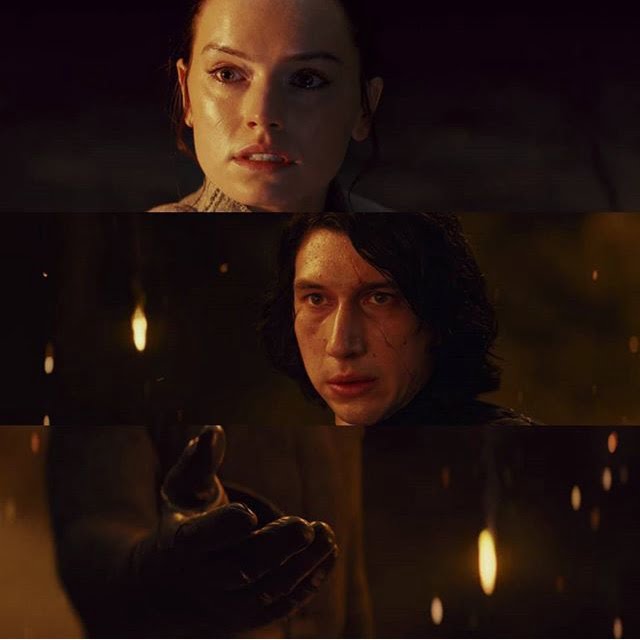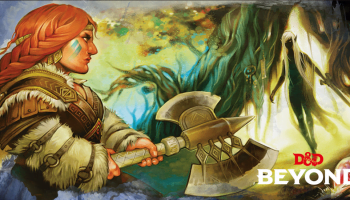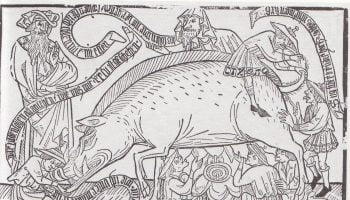Part XLII in our ongoing series on Race, Racism and the Middle Ages, by Asa Mittman. Asa’s newest book, Sea Monsters: Things from the Sea, Volume 2, coauthored with Thea Tomaini, is available now, and his next book, Medieval Monsters: Terrors, Aliens, Wonders (coauthored with is coming out June 12, 2018 and available for pre-order now.
Spoiler alert: This article contains spoilers for the final scenes of The Last Jedi.
It does not take a card-carrying medievalist to spot the echoes of medieval narratives in the Star Wars franchise. The Jedi call themselves “knights,” are called “wizards,” and dress like monks. In The Force Awakens, we find Luke Skywalker has retreated to a planet portrayed by Skellig Michael, an island off the coast of Ireland that hosts a stunning eighth-century island monastery.
The alt-right hates The Last Jedi. Charles Mudede explained why on The Stranger:
The Last Jedi is critical of meat ideology, of male leadership and mansplaining, of casino culture of the one percent, racial uniformity, an un-examined commitment to religious ideas, and arms commerce. As if this were not enough, the film ends (not really a SPOILER) with the beginning of an interracial relationship that doesn’t involve a white person […] Of course, the alt-right sees all of this as an attack on white males, and is now claiming responsibility for the low audience score the film currently has on Rotten Tomatoes.
Their obsessive hatred of The Last Jedi is also tied to white supremacists’ fascination with—even “love” for—the Middle Ages. It was therefore delightfully unexpected to see a near-perfect echo of an obscure medieval story in one of the culminating scenes. And it was even better to see that story utterly transformed into a direct refutation of alt-right ideology.
In the final act of the film, the Resistance (our heroes) have fled the First Order’s mighty army. They hole up in a cave, behind a massive wall, with no apparent escape route. Enter, the film’s crystal fox, aka the “vulptex,” who saves the day.
The vulptex seems to be a reference to a 600-year-old story, perhaps signaled through its name (derived, as it is, from Latin). This may be an intentional medieval Easter egg, or it may be just an astonishing coincidence. But the film’s progressive intentions—its thorough and clearly intentional challenges to white supremacy, toxic masculinity, misused medievalism, and the rest of the fascist alt-right ideology—crystallize (pardon the pun) in the medievalesque scene with the vulptex in a fascinating way.
John Mandeville and the Knights of Ren
The medieval story that the Star Wars fox seems to be referencing appears in several texts, including The Book of John Mandeville. The Book of John Mandeville is a fourteenth-century travel narrative about the exploits of a likely fictional narrator:
John Mandeville, Knight, albeit I be not worthy, that was born in England, in the town of St. Albans, and passed the sea in the year of our Lord Jesu Christ, 1322 … and have seen and gone through many diverse lands, and many provinces and kingdoms and isles.
The Book of John Mandeville is not very well known today. But, it was the most popular secular book of the entire thousand years of the Middle Ages. It survives in over 300 manuscripts, and in the Middle Ages was translated into nine languages. For comparison, Beowulf survives in just one badly damaged manuscript.
The Book of John Mandeville was also massively culturally influential. Among other effects, Mandeville shaped Christopher Columbus’s expectations of what he might find in “India.” Though he was deeply mistaken about his location when he came ashore, Columbus saw the people he met through the lens of Mandeville’s ideas about India.

Mandeville’s popularity is concerning, since it is deeply racist in outlook. It sets up a European norm against which the rest of the world is judged. And worse, it bears particular venom for one small minority in particular.
Mandeville recounts a story about a dangerous group that Alexander the Great is chasing, trying to wipe from the earth. He traps them in a cave behind the largest gate in the world; they cannot escape. This story was so well known that this particular gate was included on many medieval maps of the world, appearing as a giant door in a massive rock wall.
A Middle English version of Mandeville is online here (read it out loud and it will be more or less clear). In updated English (slightly modified for clarity), The Book of Mandeville says:
And if you wish to know how they shall find their way out, I shall tell you what I have heard. In the time of anti-Christ, a fox shall make there his den, and dig a hole where King Alexander made the gates; and he will mine and pierce the earth until he shall pass through towards that folk. And when they see the fox, they will marvel greatly at him, because that they saw never such a beast. For of all other beasts they have enclosed amongst them, save only the fox. And then they shall chase him and pursue him so strait, until he comes to the same place that he came from. And then they shall dig and mine so strongly, until they find the huge gates that King Alexander made of great stones, well cemented and made strong. And those gates they shall break, and so go out.

So, in other words, a fox dug a hole in the area near the gate and found the people. The people see the fox and are amazed because they have all other animals with them, but no foxes. So they chased it back to its den, and are able to break out of the cave by digging through the hole made by the fox.
That’s exactly the scene in The Last Jedi. Right down to the fox.

The Resistance is trapped in a cave behind a massive gate, outside of which lurks the Imperial army in all its might. As C3PO tells them, “BB8 has analyzed the mine’s schematics, and this is the only way in—or out.” There is no escape. But then, they notice a vulptex, and “pursue him” to a hole that is partially blocked with “great stones.” Ultimately, Rey is able to break them apart and free her compatriots through the power of the Force.
But here’s the kicker: in the original 14th-century text, the people described are the Jews.
“Funny, she doesn’t look Druish…”
The “folk” are, as Mandeville calls them in Middle English, “the Jewes.” The story of Alexander the Great was borrowed from ancient history by medieval artists and authors (like Mandeville) and transformed into a model of Christian kingship.
Here, Alexander is trying to imprison and destroy the Jews. Why? Because, as Mandeville (along with many other medieval stories) tells us, if they do not, those Jews will escape and destroy the world order. Mandeville says:
In the time of anti-Christ, … [the Jews] shall make great slaughter of Christian men … [and will] destroy the Christian people … [and] Christian men shall be under their subjection, as long as they have been in subjection under them.
They will end what these authors saw as the rightful hegemony of white, male, Christian Europe. Mandeville’s author (who may or may not actually be someone called John Mandeville), and the majority culture of medieval Europe thought this would be a bad thing.

That is, when the trapped Jews follow the fox to escape from the caves, they will then destroy the all-powerful, world-controlling empire that has tried and tried to eradicate them, and then will hold in subjugation those who once subjugated them. This is also, in essence, Kylo Ren’s offer to Rey. After their battle in Snoke’s throne room, he offers for them to join forces (recalling Vader’s offer to Luke) and replace the violent, intolerant, fascist (new) First Order (which replaced the violent, intolerant, fascist Empire) with yet another of violent, intolerant, fascist Slightly Newer Order.
Outfoxing the Alt-Right
There are two crucial differences between the old and new fox tales. First, in Mandeville, the territory-conquering ruler is the hero of the story. In this story, Alexander is as good a representative of prideful, conquering, violent, imperial patriarchy as one could ever want. This makes him heroic (if flawed) in medieval narratives.

In The Last Jedi, these roles are reversed. The villains are the colonialist conquerors, here embodied in the patricidal Kylo Ren and his second in command (with an alt-right haircut), General Hux.
The second important difference is that The Last Jedi refuses the racist narrative that birth and lineage are destiny, a narrative that unfortunately plagued other installments of the franchise. The officers of the jackboot-wearing First Order are almost entirely white, male, human, and hell-bent on the domination and elimination of all otherness. If anything, the seemingly only woman in their ranks, Captain Phasma, is as much an exception that proves the rule. And similarly, one frosted-tipped darling of the real-world alt-right characterizes their movement as celebrating “homogeneity over diversity,” which, not coincidentally, is a fundamental element of how they imagine the Middle Ages to have been.

The Resistance, on the other hand, is gloriously filled with plurality and color. This fundamental difference is at the core of why the fascists hate them. The fascist aesthetic of the First Order—its shiny, polished boots, buttons, and floors—is a reflection of an ideology that sees difference as disorder, and disorder as a problem to be polished out of existence. The aesthetic of the Resistance, by contrast, shows how difference is strength. Not only are the Resistance fighters not all members of a tribe or sect, they are not even all members of the same species.
Star Wars: The Last Jedi transforms a toxic medieval story into a celebration of diversity. The medieval tale is a celebration of (and anxiety about) the power of the conquering empire to imprison and eliminate those who refuse to be assimilated. It is a meditation on those who refuse to submit to a society based on whiteness, uniformity, conformity, masculinity, and barely sublimated daddy issues.
The Last Jedi tells the same story, with all these same themes, but turns it into a spark of hope for a better, more-inclusive world. The film provides a model for how to engage with the compelling stories of the medieval past without repeating the errors of their authors. That’s a fox worth following.
If you enjoyed that article, please share it with your history-loving friends on Facebook, or on Twitter! And be sure to subscribe here to receive every new article from The Public Medievalist the moment it launches.





Comments are closed.